Monday, March 22, 2021
Science WAS entertainment before Darwin
Trying to find a detail of an old electrotherapy device, ran into this perfectly wonderful 1856 catalog from a NYC science supply company.
The cover page shows the building on bustling and bustled Broadway:
 [Picture may contain: 4 people and 1 dog, all with their tails up]**
Benjn Pike Jr was an optician, and his primary product was microscopes. The catalog includes a lengthy and useful discussion of gathering and preparing specimens, including what to look for and where to look.
Here's what Pike thought of design vs random:
[Picture may contain: 4 people and 1 dog, all with their tails up]**
Benjn Pike Jr was an optician, and his primary product was microscopes. The catalog includes a lengthy and useful discussion of gathering and preparing specimens, including what to look for and where to look.
Here's what Pike thought of design vs random:
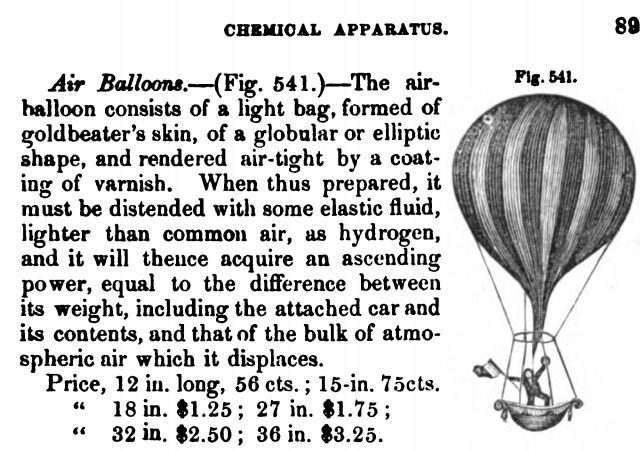 An alarm bell as a demonstrating toy, not as an EMERGENCY WARNING.
An alarm bell as a demonstrating toy, not as an EMERGENCY WARNING.
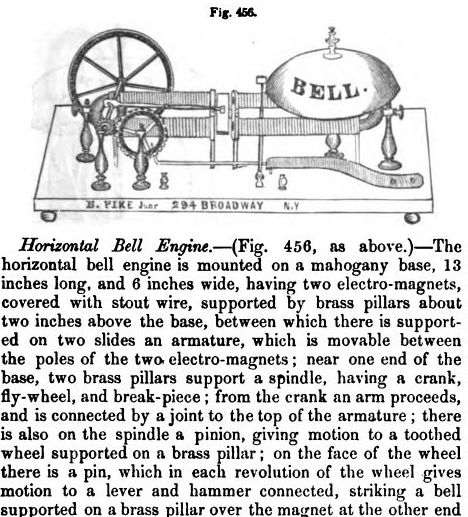 Simultaneous demo of battery action and electromagnetism.
Simultaneous demo of battery action and electromagnetism.
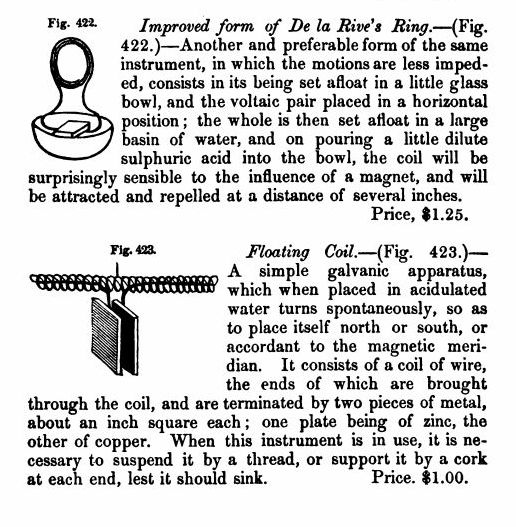 Simultaneous demo of thermocouples and electromagnetism.
Simultaneous demo of thermocouples and electromagnetism.
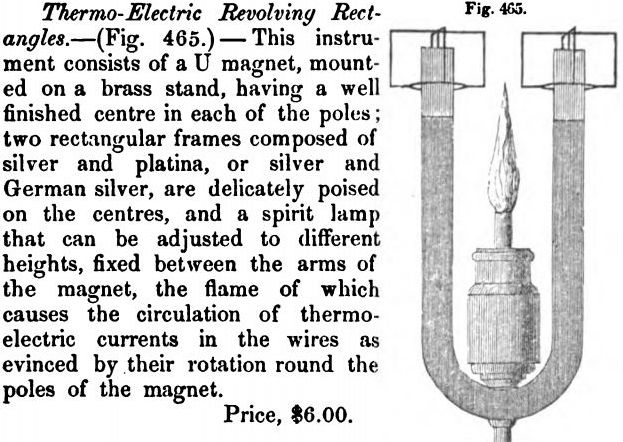 Not clear how this worked, but it must have been dramatic. Lockey also designed a component of an electrotherapy device, which is what steered me into this catalog. Magic<->Medicine.
Not clear how this worked, but it must have been dramatic. Lockey also designed a component of an electrotherapy device, which is what steered me into this catalog. Magic<->Medicine.
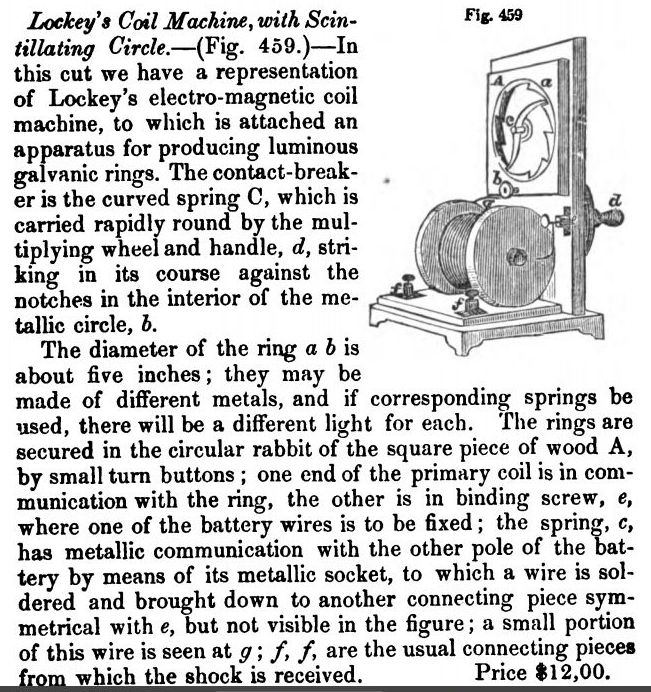 Magnetic toys.
Magnetic toys.
 Demo of a monostable multivibrator.
Demo of a monostable multivibrator.
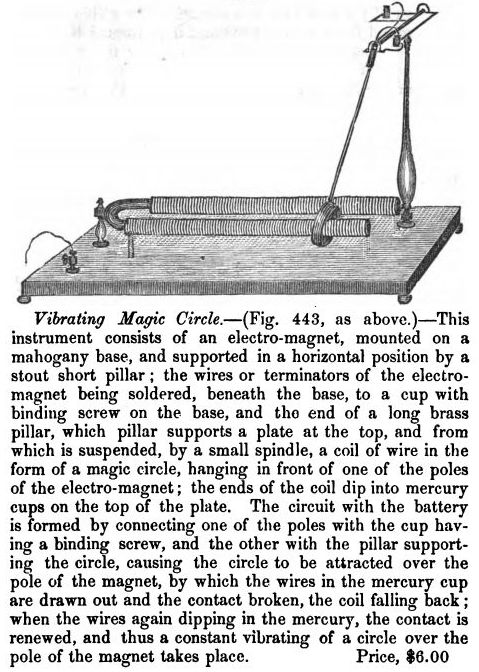 Finally, here's an item that fits into my earlier suggestion about useful modern science fun... and it's also a liquid bridge.
Finally, here's an item that fits into my earlier suggestion about useful modern science fun... and it's also a liquid bridge.
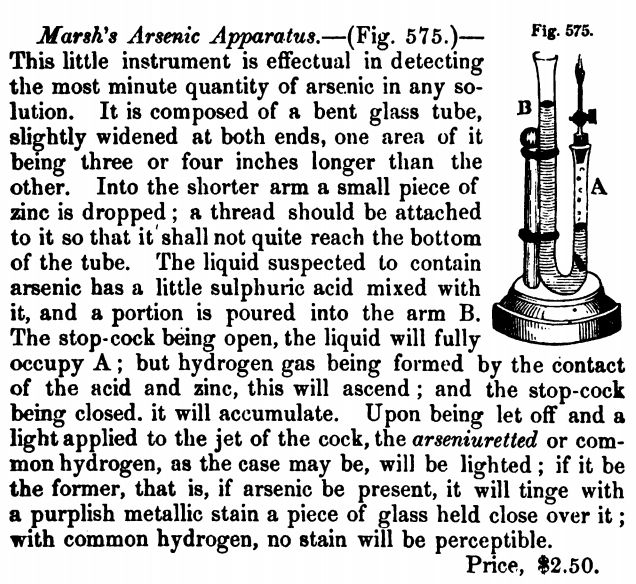 = = = = =
** Tailnote: How the hell did ladies SIT in those outfits? Needless to say, Youtube provides the answer, and it's amazing. The bustle wasn't a pillow, it was a complex and collapsible mechanism. As the above picture suggests, the hoop skirt protected ladies against both dogs and wolves.
= = = = =
Continued in Part 2, focusing on the Magnetic Machine.
= = = = =
** Tailnote: How the hell did ladies SIT in those outfits? Needless to say, Youtube provides the answer, and it's amazing. The bustle wasn't a pillow, it was a complex and collapsible mechanism. As the above picture suggests, the hoop skirt protected ladies against both dogs and wolves.
= = = = =
Continued in Part 2, focusing on the Magnetic Machine.
 [Picture may contain: 4 people and 1 dog, all with their tails up]**
Benjn Pike Jr was an optician, and his primary product was microscopes. The catalog includes a lengthy and useful discussion of gathering and preparing specimens, including what to look for and where to look.
Here's what Pike thought of design vs random:
[Picture may contain: 4 people and 1 dog, all with their tails up]**
Benjn Pike Jr was an optician, and his primary product was microscopes. The catalog includes a lengthy and useful discussion of gathering and preparing specimens, including what to look for and where to look.
Here's what Pike thought of design vs random:
Equivocal or spontaneous generation, that is, the production of plants without seeds, and of living creatures without any other parents but accident and putrefaction; such was the absurd opinion that prevailed of the production of the minute living creatures, before the microscope overturned it, by demonstrating that all plants have their seeds, and all animals their eggs, whence the same species are produced. Nothing seems more contrary to reason, than to suppose that chance should give being to regularity and beauty, or that it should create living animals, fabricate a brain, nerves, and all the parts of life; and we may as well suppose that the woods generate stags and other animals that inhabit them, as that a cheese generates mites without the egg.THE MICROSCOPE OVERTURNED RANDOMNESS. This was written just three years before Darwin brought Spontaneous Generation back into fashion. Note the clear logic: Nothing seems more contrary to reason, than to suppose that chance should give being to regularity and beauty, or that it should create living animals, fabricate a brain, nerves, and all the parts of life. Modern school textbooks still make fun of the idea that each individual creature could generate spontaneously, and then declare as an absolute unarguable axiom that each species must have generated spontaneously, and life itself must have generated spontaneously.
The growth of animals and vegetables seems to be nothing more than a gradual unfolding of their parts till they obtain their full size. Though water, by merely standing a few days, will be found to contain them, yet they will not be found in any degree so numerous as when vegetable bodies have been steeped therein, for no living creatures seem to subsist upon water alone; but when it is stored with their proper food, myriads may be found in every drop, of the greatest variety in their forms: some are round, some oblong, and others spherical, and the greatest part of them transparent: motion seems to be their greatest delight; they pervade with ease and the greatest rapidity the whole dimensions of the drop of water, in which they find ample space; sometimes they dart forwards, and at others more obliquely; then again in a circle, and though hundreds may be seen in a single drop, yet they never strike against one another.Motion is their greatest delight. These are LIVING THINGS with purpose and emotion.
They differ in their size; some are barely visible to the eye; some so minute as to resist the action of the microscope, and appear only as moving points; of this description is the monus; it is so extremely delicate and transparent, as some times to elude the highest magnifying power.Monus? Google doesn't find it at all. The word is clear in the printed book, but I wonder if the typesetter was misreading a handwritten manuscript, like nonims. The two words contain the same confusable letters. Aha. Monas, not monus. That was easy. = = = = = Most of the catalog is aimed at schools and performers, especially magicians. Magic overlaps medicine, with the same devices serving both purposes. Air balloons. Note the French flag.
 An alarm bell as a demonstrating toy, not as an EMERGENCY WARNING.
An alarm bell as a demonstrating toy, not as an EMERGENCY WARNING.
 Simultaneous demo of battery action and electromagnetism.
Simultaneous demo of battery action and electromagnetism.
 Simultaneous demo of thermocouples and electromagnetism.
Simultaneous demo of thermocouples and electromagnetism.
 Not clear how this worked, but it must have been dramatic. Lockey also designed a component of an electrotherapy device, which is what steered me into this catalog. Magic<->Medicine.
Not clear how this worked, but it must have been dramatic. Lockey also designed a component of an electrotherapy device, which is what steered me into this catalog. Magic<->Medicine.
 Magnetic toys.
Magnetic toys.
 Demo of a monostable multivibrator.
Demo of a monostable multivibrator.
 Finally, here's an item that fits into my earlier suggestion about useful modern science fun... and it's also a liquid bridge.
Finally, here's an item that fits into my earlier suggestion about useful modern science fun... and it's also a liquid bridge.
 = = = = =
** Tailnote: How the hell did ladies SIT in those outfits? Needless to say, Youtube provides the answer, and it's amazing. The bustle wasn't a pillow, it was a complex and collapsible mechanism. As the above picture suggests, the hoop skirt protected ladies against both dogs and wolves.
= = = = =
Continued in Part 2, focusing on the Magnetic Machine.
= = = = =
** Tailnote: How the hell did ladies SIT in those outfits? Needless to say, Youtube provides the answer, and it's amazing. The bustle wasn't a pillow, it was a complex and collapsible mechanism. As the above picture suggests, the hoop skirt protected ladies against both dogs and wolves.
= = = = =
Continued in Part 2, focusing on the Magnetic Machine.Labels: Entertainment, Equipoise
